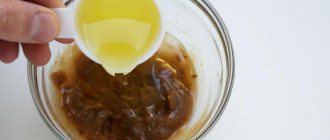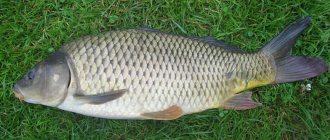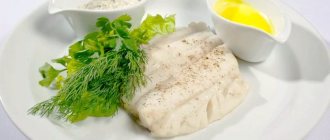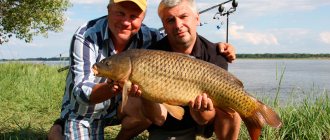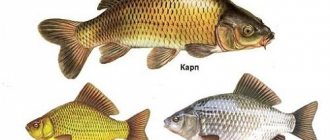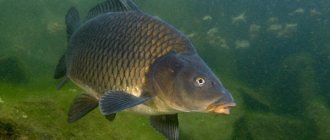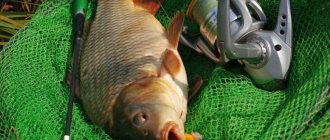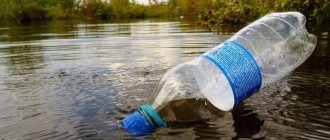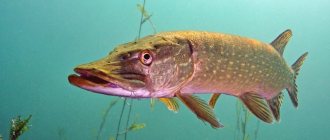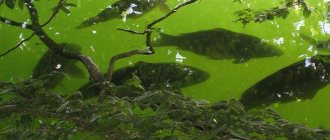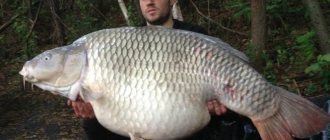Mugs are one of the possible equipment for carp fishing. This is a simple and unpretentious tackle that allows you to leave the reservoir with a decent catch , but for this you need to understand all the intricacies of fishing with mugs.
Even a beginner can make their own mugs and use them effectively.
Does it make sense to fish with mugs?
During the spring zhora, carp actively moves around the reservoir in search of food, so finding and catching it is not difficult with any tackle . In this case, it is more convenient to use a float rod. However, from the beginning of summer until September, the carp has already fattened up, and its activity is reduced to a minimum. In summer there is plenty of food in any part of the reservoir , so carp prefers safe places like deep holes and other natural shelters, often far from the shore. It rarely moves, which means it is very difficult to find.
Racks for carp and carp help place the tackle anywhere on the pond. And if you consider that you can place several circles, then the efficiency of fishing increases significantly . At the same time, you can deliver bait to the most potentially “fishy” places without significant effort . In addition, carp become timid and avoid any extraneous sounds . A banal blow of the rod on the surface of the water can make the fish refuse food . The mugs, in turn, make absolutely no sounds .
Arrangement of circles
The stakes for carp fishing are similar to the stakes for pike. This is a floating tackle that consists of the following elements:
- A round disk with a groove is used as a float and reel at the same time. It is made from lightweight buoyant materials . It can be wood, plastic or foam. Such tackle can be found in any fishing store or you can make it yourself. The diameter of the disk should be approximately 10-12 cm, thickness up to 3 cm. The groove is made up to 1 cm deep, depending on how much fishing line is placed in it.
- Rod - inserted into the float disk . passes through it and is fixed , so there should be small grooves in the rod . Length – up to 20 cm .
- Line - the main line that is wound onto the disk . For carp fishing, 0.24 - 0.3 mm monofilament fishing line is sufficient. large specimens of more than 10 kg in the reservoir 0.4 mm or use braided wire. You will need about 30-40 m of fishing line.
- Leashes are attached to the main line using a knot or carabiner. It is advisable to use thin leashes no more than 0.2 mm or less from braided fishing line . The length of the leashes is 30-40 cm . The color must match the fishing conditions, that is, the bottom. 1-2 leashes on one circle . Experienced fishermen limit themselves to one leash, as several pieces can get tangled or overlap.
- Sinker - attached to the main fishing line , possibly in the same place where the leash is attached. To prevent overlapping, a branch is used . For fishing in still water 15-20 g of sinker weight is enough during currents, double the weight or tie the tackle to aquatic vegetation, if possible.
- Hooks – use single and double types of hooks, but specifically carp hooks. They have a special design to increase the chance of successful hooking. Hooks are not suitable for predatory fish. The size of the hooks depends on the size of the carp in the pond .
Important! Carp mugs can be used for pike fishing and vice versa. The gear is very similar.
Features of the gear device
This gear for carp almost completely replicates the design of the pike version, except that the diameter of the circle itself in the case of peaceful fish is somewhat smaller.
Actually, the circle itself
A circle is nothing more than a disc made of lightweight material that can float on the surface of the water. It must be well painted, otherwise there is a risk that the tackle will quickly become unusable. Sometimes spools of fishing line of suitable diameter are used as a circle. At the same time, the option for carp is usually smaller than the pike one and is not painted in bright colors so as not to scare away wary fish.
Mast
Which simultaneously performs the function of a keel. A fishing line is fixed on one side, while the other ends in a ball, which, when bitten, when the disk turns over, indicates that the circle should be checked for a catch.
Main line
When choosing a diameter, you should focus primarily on the expected size of the catch. For relatively small carp, a fishing line of 0.22-0.26 millimeters is also suitable, but for a more serious catch weighing 3 or more kilograms, it is worth choosing a fishing line with an appropriate breaking load.
Leash
The diameter of the leader depends primarily on the diameter of the main line. The leash, naturally, should be somewhat thinner. For reservoirs with high fishing pressure, fluorocarbon options that are invisible in the water are a good choice. It is either tied to the main line with a knot or with a swivel. The length is usually small, up to 30–40 centimeters.
Sinker
A small sinker is suitable, most often it is an olive, weighing about 15–20 grams; a heavier weight is usually not particularly necessary, because carp is not one of those fish that likes strong currents.
It is generally accepted that carp circles should not be too bright so as not to frighten wary fish. Important! Instead of one hook with a nozzle or a hook with a hair rig, you can use various multi-hook options like a “cork” or “carp killer” rig. These are completely unsportsmanlike, but quite effective gear with a self-hooking effect.
Carp killer or crucian carp killer. Such tackle, used on carp circles, especially with a large number of hooks placed, is practically a poaching tool.
What to catch?
When choosing bait, they use the experience of fishermen on a specific body of water at a specific time. Carp is an omnivorous fish, but this does not mean that it will bite on everything . Even within one day, its tastes can change several times.
It is only important to understand that carp prefers high-calorie food; it will not waste time eating small fractions or worms (we are talking about large individuals). Carp loves large and satisfying pieces of food.
The following types of baits and attachments are used to catch carp
- small potatoes;
- corn (boiled or canned);
- peas;
- May beetle larvae;
- large worms;
- a bunch of maggots or bloodworms;
- dough;
- semolina;
- berries (strawberries, plums, cherries, etc.);
- pearl barley;
- cake;
- boilies.
Large baits are placed on the hook one by one, small ones in bunches or several pieces. You can mix baits and attachments, for example, attach a bunch of maggots and an additional 1-2 pieces of pearl barley. Carps love “sandwiches” .
Dill, cake, sunflower oil, anise, hemp oil, linseed oil, and vanilla are used as flavoring agents for baits Under no circumstances should you mix flavorings - this will definitely scare away the fish. Carp have a highly developed sense of smell, so a small amount of flavoring, for example in semolina or dough, is sufficient.
Lure
Feeding for carp is the same as for most white fish. These are cereal porridges: millet, semolina, barley, pearl barley. Pea porridge, fish meal and milk powder are also used.
They take one thing as a base millet porridge is best, to which they additionally add something aromatic, for example, cake, and always a small amount of large fractions (corn, peas, nuts, mixed feed, boilies, berries, etc.).
overly saturate the complementary foods - this, again, can scare off the carp. In fished reservoirs, it is unlikely that anything will scare off the carp, but in “wild” places to offer carp cherries or boilies with an exotic taste as bait or bait.
Complementary food is thrown into the water right next to the circles. The consistency of the bait should not be too wet , but not dry . You need to sculpt round balls that should not fall apart upon first contact with water, but also not be overly dense. Humidity is selected individually. You can check the condition of the bait near the shore in advance. If the balls begin to fall apart only at the bottom, and gradually, then the humidity of the bait is suitable.
Advice. To moisten the bait, it is better to use water from a pond. Additionally, you can add a handful of soil taken from the shore. This will lull the carp's vigilance and reduce the chances of the fish being spooked by unfamiliar smells.
Bait for carp and carp
Choosing a fishing spot
The best places for carp fishing in the warm season are:
- deep holes;
- underwater shelters (snags, fallen trees);
- coastal vegetation (overhanging bushes, thickets of reeds or reeds);
- sharp drops in depths;
- creeks and washed with considerable depth;
- holes after rapids (on rivers).
Carp can bite throughout the day , but the most successful may be at night and early morning , when the fish are less careful.
How to fish with mugs?
After equipping the circles, they are thrown into the water . The easiest way to do this is from a boat . It is enough to throw the sinker to the bottom or tie the tackle to something, for example, to the reeds. The sinker will sink to the bottom, and the line will be released from the disk itself. The distance between circles must be at least 10 m .
Attention! It is important to install the mugs without unnecessary noise so as not to scare away the fish.
Once all the mugs are installed, you can return to shore. Bites will be visible from the movements of the surface parts of the tackle, that is, the circle itself.
There is no need to rush and rush into the water for fish. It is better to wait until the carp hooks itself and only then swim so as not to scare it away. A hooked fish will swing the circle and pull off the line.
First of all, a hooked carp tends to go deeper or to another shelter. Large fish will have to be starved out. Carp have strong and thick lips, so the hook digs into them reliably, but still you shouldn’t force things The fish must be prevented from swimming, thus depleting its strength. After the carp is exhausted, it can be dragged to the shore. However, every 20-30 seconds the fish will try to make another jerk. If you manage to lift the carp to the surface of the water, it will lose consciousness for some time from the large amount of oxygen, in this case it will be very to pull .
Video of carp fishing with a circle:
What kind of gear is this - a bottle?
Making such equipment is extremely simple. Take a bottle and a fishing line 8 meters long. The fishing line is tied to the neck and wound from the neck of the bottle onto its narrow part (recess). An elastic band is wound around the recess on the other side. After this, a sliding weight, a leash, a swivel clasp, a double and an elastic band are attached to the fishing line.
How to catch fish with a plastic bottle? Having attached the live bait, you need to measure the fishing line from the hook to the desired depth, then put the fishing line behind the elastic band and secure it. To create an inclined or vertical position of the bottle, you can pour a certain amount of water into it.
When fishing with a bottle, when a fish bites, it pulls the line behind it, which tears the line off the elastic, unwinds and turns over or changes the tilt of the bottle. The fisherman, swimming in a boat to the tackle, hooks the fish.
The video shows how the tackle for catching fish with a bottle is prepared.
Although the author of the previous video calls this method not very sporty, the authors of the next video do not agree with this.
DIY mugs
The design of carp circles is extremely simple. First you need to make a round disk with a diameter of 15-20 cm. The material must be buoyant. Foam or wood works best A groove up to 1 cm deep is made along the rim of the disc 0.5-1 cm hole is drilled in the center of the disk a rod is selected to it. There should be a hole in the rod itself for the fishing line.
Then the main fishing line is wound onto the disk, and a leash with a hook and a leash with a sinker . The tackle is ready.
Making a “nipple” for carp with your own hands
If a fisherman decides to test himself in the skill of independently making gear for carp fishing, then this work should begin after all the necessary materials and tools have been prepared.
For the “pacifier” you may need:
- Cork from a plastic bottle.
- A flat lead sinker with an eye, weighing 10 g.
- Drill and metal drill bit with a diameter of 2 mm.
- Hooks number 6-8 and braided line with a diameter of 0.15 mm.
- Self-tapping screw for metal, with a wide head, 3 mm in diameter and up to 15 mm in length.
Installation process:
- The plastic plug is installed on a flat sinker so that the center of the plug is aligned with the center of the sinker.
- Using a 2 mm drill, a through hole is made exactly in the center of the plug and sinker.
- A self-tapping screw is screwed into the hole on the side of the plug.
- Along the side circumference of the cork, 4 holes with a diameter of 2 mm are drilled, equidistant from each other, into which leashes 5-6 cm long are inserted, so that the hooks are inside the cork. The free ends of the leashes are tied to the eye of the sinker. The tackle is ready!
When installing a “nipple”, if the length of the screw is greater than the total thickness of the bottom of the plug and the sinker, the part of the screw coming out of the sinker should be sawed off.
Hooks should be equipped with foam balls so that the fish, when sucking the bait, do not feel the prick from the sharp sting of the hook.
"Nipple" from a spoon
You can make this tackle from a tablespoon. The advantage of this design is that the “nipple” does not need to be additionally equipped with a sinker; the metal of the spoon copes well with the function of weighing the bait.
To make such gear you will need the following materials and tools:
- Stainless steel tablespoon.
- Copper wire with a diameter of 2 mm.
- Hooks numbers 6-8 and braided fishing line with a diameter of 0.15 mm.
- Drill and drill bit for metal with a diameter of 2 and 4 mm.
- Hacksaw for metal.
- File.
Using a hacksaw for metal, the handle of the spoon is sawed off at the point where it attaches to the scooping part of this cutlery. The place where the metal was separated should therefore be carefully processed with a file so that there are no sharp edges that could damage the fishing line.
At the sawing site, moving 2-3 mm from the edge, it is necessary to drill a hole with a diameter of 2 mm to attach the fishing line to this tackle. The hole must be chamfered on both sides using a larger diameter drill.
Two-millimeter holes should be drilled on each side of the spoon in the amount of 4 pieces, 2 holes on each side. When drilling these holes, you should also step back slightly from the edge.
2 pieces 4-5 cm long are separated from the copper wire. Each piece is bent in an arc and installed in opposite holes of the spoon and fixed in the hole by crimping the metal on both sides.
Leashes, in the amount of 4 pieces, with hooks are tied to the main hole for attaching the main fishing line, and are placed inside the tackle after the bait is placed inside this structure.
"Nipple" made from a spring
You can make a spring for the tackle yourself. Copper wire with a diameter of 3 mm is successfully used for this purpose. The wire is wound onto a tube or rod with a diameter of 15-20 mm.
The number of turns and the step between them are selected individually, but too large a distance between turns is undesirable due to unsatisfactory retention of the bait in such gear.
The fastening of the “nipple” of this design is blind; the main line is tied directly to the coils of such a spring. Leashes with hooks are also attached to the spring.
How to increase your fish catch?
Over 7 years of active fishing, I have found dozens of ways to improve the bite. Here are the most effective ones:
- Bite activator. This pheromone additive attracts fish most strongly in cold and warm water. Discussion of the bite activator “Hungry Fish”.
- Increased gear sensitivity. Read the appropriate manuals for your specific type of gear.
- Pheromone-based lures.
Tips for catching carp/carp with mugs
When fishing for carp with mugs, you need to follow a few useful tips:
- first clarify how many mugs per person can be used. Usually the maximum allowed is 5-10 pieces . There may be members of fishing clubs and license .
- The distance between the circles should not be less than 5 m become tangled after a bite .
- It is better to throw mugs from a boat . This practically does not scare the fish and allows you to deliver the tackle to the right place without problems.
- It is recommended to equip mugs with various types of attachments and baits. After the first bites, it will be possible to draw conclusions about the preferences of the carp that day.
- Carp are voracious, so it is difficult to overfeed them. You can throw up to 0.5 kg into the place where the mug is thrown every 3-4 hours .
- It is better the forend of , although this is not a necessary condition. The fact is that carp sometimes prefer to savor the bait, and only then swallow it. If the fore-end sticks out, the fish may prick itself and spit out the bait.
- The location of carp activity can be seen by characteristic splashes in the water. This means the fish is feeding and is ready to bite .
Mugs can be a real lifesaver. The gear is simple, convenient and most importantly effective. It can be installed anywhere in the reservoir literally under the nose of the carp. If the fish likes the bait, then a bite is guaranteed. Feeders and float rods do not allow you to fish large areas of a reservoir at the same time, therefore they are less effective, especially in the summer .
Useful tips
- If you make mugs for carp yourself and choose wood as the material for the disc, then give preference to linden (spruce or pine will do). It is lightweight and easiest to process. Naturally, the wooden circle must be soaked in drying oil and covered with waterproof paint. Otherwise, the tackle will quickly fail.
- In many reservoirs, carp can be very cautious and even shy. To catch such fish, it is better to use a smaller version of circle gear. That is, the diameter of the circle is no more than 10 cm, and the thickness is approximately 1 cm. If you use large circles, then there is a high chance that the splashes when they are turned over will frighten the carp.
- Carp are successfully caught with mugs even in hot weather, when it swims near the surface. To do this, the sinker is removed from the tackle, and bread (or even crusts) or floating boilies are placed on the hooks. The latter version of the attachment is more preferable, because the bread crust and even crackers quickly become soggy and easily fly off the hook.
- When fishing for carp with mugs, proper fishing plays an important role. After all, if you give the fish a little slack, it will easily go into the snags. At the same time, carp are a big fan of swimming around some obstacle several times. The same branch or snag. As a result, it is no longer possible to pull out the fish - all that remains is to cut or tear the fishing line.
In the video we will talk about catching carp with mugs:
